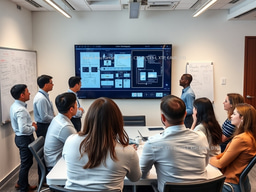The Essential Tool for Acoustic Calculations and Design

I was surprised to learn that some electrical engineers working in AV consultancy roles are not familiar with EASE (Enhanced Acoustic Simulator for Engineers), which is crucial for ensuring that any audio system design meets project specifications and standards. Below, I will outline some of the most important aspects:
EASE is a powerful software that transforms AV design by simulating sound propagation in 3D environments. It plays a critical role in optimizing acoustics for spaces such as :
🏟️ Stadiums.
✈️ Airports.
⛪ Places of Worship.
🏢 Multipurpose Halls.
🗣️ Conference Rooms.
But why is EASE so important in modern acoustic design?
What is EASE?
EASE is a specialized software that simulates sound propagation in 3D environments. It uses advanced techniques like ray tracing and wave-based models to predict sound behavior with remarkable accuracy. Compatible with real-world hardware setups and data integration, EASE enables engineers to visualize and analyze the acoustic characteristics of a space before physical implementation.
The Importance of EASE in Acoustic Design
- Ensures Sound Quality and Clarity:
- SPL (Sound Pressure Level): EASE allows designers to calculate and visualize SPL distribution across a venue. Proper SPL mapping ensures consistent sound levels without dead zones or overly loud areas comparing to projects Specification .
- STI (Speech Transmission Index): EASE evaluates speech intelligibility, which is essential in spaces like conference rooms, airports, or auditoriums. High STI ensures clear communication, enhancing user experience, usually range of (0.55 - 0.77 ) is acceptable and sufficient to have clear intelligibility,
- Optimizes Speaker Placement and Design:
- Simulates speaker performance based on specific specifications to determine optimal placement, aiming angles and coverage patterns; based on data sheet of desired loudspeakers.
- Prevents issues such as comb filtering, excessive reflections or overlaps between speakers, which can degrade audio quality.
- Evaluates Material Effects on Acoustics:
- Incorporates material absorption coefficients to simulate how surfaces (walls, ceilings, floors) interact with sound ; in order to avoid any adoptive work during construction phase.
- Helps select appropriate materials to manage reverberation, echoes and overall acoustic response effectively.
- Saves Time and Reduces Costs:
- Identifies acoustic challenges during the design phase, minimizing costly post-installation adjustments during construction phase :
- Reduces trial-and-error by providing a virtual environment to test design choices before implementation.
- Facilitates Compliance with Standards:
- Ensures designs meet regulatory and industry standards for acoustics and sound pressure levels, such as those specified by AVIXA or any other worldwide standards.
- Supports achieving certification requirements for acoustic performance, ensuring project success.
- Enhances Collaboration and Communication:
- Provides clear visual and numerical data that can be shared with architects, clients and other stakeholder specially with AV consultant to review Ease report and comment for any project requirement discrepancies.
- Helps non-technical stakeholders understand the impact of acoustic design decisions on project outcomes.
- Versatility Across Projects:
- Applicable to diverse spaces, from small conference rooms 3 x 5 meters to to large arenas.
- Adapts to unique challenges like irregular layouts or challenging materials.
8. Case Studies and Real-World Applications:
A few years ago, I commissioned a 500-seat multi-purpose theater designed for diverse performances. The space featured line array speakers, wooden seats and a mix of reflective (cement ceiling) and absorptive (wooden walls) surfaces, creating unique acoustic challenges.
a. Challenges
- Managing reflections from the cement ceiling to prevent excessive reverberation.
- Balancing sound distribution with varying absorption coefficients from wooden surfaces.
- Ensuring consistent SPL and STI for clear audio throughout the venue.
b. Using EASE, we analyzed the space with these steps:
- Material Modeling: Inputting the acoustic properties of walls, seats and ceilings to simulate their sound impact.
- Speaker Placement: Optimizing line array positions to eliminate comb filtering and ensure even coverage.
- Performance Metrics: Achieving an SPL balance and an STI range of 0.60-0.75 for speech intelligibility.
- Reverberation Control: Managing RT60 for balanced clarity in speech and music.
c. Results:
The simulation enabled precise speaker placement, ensuring uniform sound quality. Collaboration among stakeholders was streamlined and costly post-installation adjustments were avoided, delivering a high-performance, acoustically optimized space.
10. EASE and the Future of Acoustic Design:
As technology advances, EASE continues to evolve with features like integration with AI and VR. These innovations allow for more immersive simulations, making it easier for designers to create sustainable and efficient acoustic solutions.
Manufacturers like Bose Professional, Biamp, d&b Audiotechnik, L-Acoustics, Electro-Voice (EV), JBL Professional (Harman), Renkus-Heinz, Meyer Sound, QSC ( alongside many other industry leaders) provide EASE files (GLL files) for their products. These files enable precise acoustic modeling and simulations within the software.
Finally , I can conclude that EASE is indispensable in AV designing and engineering because it bridges the gap between theoretical design and real-world application. By allowing engineers to analyze SPL, STI and material absorption coefficients, EASE ensures sound systems meet both functional and aesthetic requirements. Whether designing for a small conference room or a massive stadium, EASE empowers professionals to deliver exceptional acoustic experiences.
-
Xchange Advocates are recognized AV/IT industry thought leaders and influencers. We invite you to connect with them and follow their activity across the community as they offer valuable insights and expertise while advocating for and building awareness of the AV industry.
Recommended Content
LetsTalkAVbyAlexis Series: Episode 4 : Design Begins With People: Engineering AV Systems Around Real End-User Requirements

LetsTalkAVbyAlexis Series : Episode 2: Network & AV Convergence (AVoIP)





Please sign in or register for FREE
If you are a registered user on AVIXA Xchange, please sign in
This was very informative
I completely agree with this article—EASE is such a game-changer for anyone working in AV design. It’s surprising to hear that some electrical engineers in the field aren’t familiar with it, considering how essential it is for getting audio systems right. The ability to simulate sound in 3D and tackle issues like SPL distribution, STI, and material absorption before anything is installed is such a time-saver and ensures the design actually works in the real world.
I also love how EASE makes collaboration so much easier. Being able to show architects, clients, and other stakeholders exactly how the sound will behave helps get everyone on the same page. Plus, with the integration of AI and VR, it’s only going to get better—making acoustic design more efficient and accurate than ever.
If you’re in AV design and not using EASE, you’re definitely missing out. It’s one of those tools that’s absolutely worth learning.
An important distinction is to note that while EASE base version provides information about acoustics, that data is estimated and the RT information can be largely inaccurate. EASE with Aura, is required to perform accurate wave based modeling. EASE standard is limited in its acoustic analysis performance.